NTBG’s Limahuli Preserve, located in the steep, rugged mountains of Kaua’i’s North Shore, and partially cloaked in montane forest, is home to some of the world’s rarest — and most threatened — plants. Covering nearly 1,000 acres on the oldest of Hawai’i’s high islands, Limahuli is one of the most biodiverse valleys in the Hawaiian archipelago.
The rich tapestry of native plants that has evolved here over millennia composes complex forest communities, creating habitat for plants such as koki’o ke’oke’o (white hibiscus) and nānū (native gardenia), which in turn support other species. The forest that forms the uppermost tier of the Limahuli watershed nourishes all life in the valley below, down to and including nearshore fisheries.
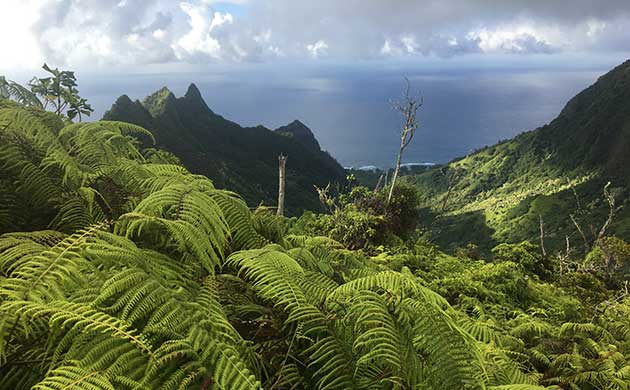
Land snails, stream fish, shrimp, damselflies, endangered water fowl, and endangered ground-nesting seabirds, such as ʻa’o (Newell’s shearwater) and ‘uaʻu (Hawaiian petrel), all depend on Limahuli for their survival. But Limahuli’s plants and the life they support face a myriad of threats from non-native insects, plant diseases, destructive animals such as pigs, rats, and cats as well as invasive plants and a changing climate.
Limahuli is also central to long-held Native Hawaiian cultural practices and traditions that rely on the plants that live in this valley.
For more than 40 years, NTBG’s Conservation staff has been working to protect and preserve this rich forest habitat and spends more than 10,000 hours working in the biocultural preserve annually. Limahuli Preserve also provides an important environment for scientists and researchers from across Hawai’i and beyond to conduct important, often groundbreaking, scientific studies. Below, Limahuli Garden and Preserve’s former director, Dr. Kawika Winter, answers questions about some of the latest research carried out at Limahuli.
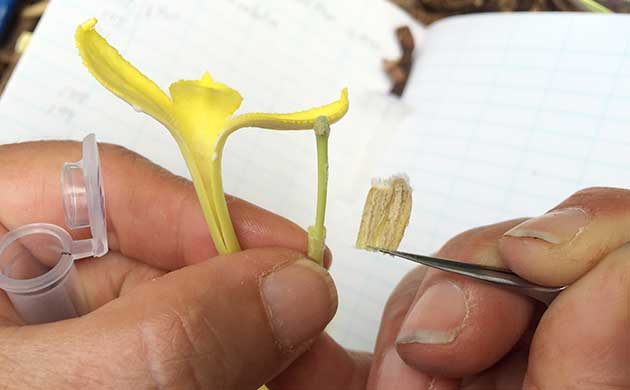
Recently there has been some interesting research happening at Limahuli Garden and Preserve that led to the publication of two articles in a special issue of the journal Pacific Science (University of Hawai’i Press). Can you tell me about these?
One of the articles focused on an attempt to figure out how we can manage the biocultural resources of Limahuli Valley in ways that are founded in traditional resource management.
What are some specific examples of the kind of research you did?
When I started here in 2005, part of my charge was to take on the Hā’ena Ahupua’a Project, which aimed at restoring the health and function of this ahupua’a, or traditional land division, which goes from the mountains to the sea.
When attempting ahupua’a restoration, it is pretty straight forward — when you’re looking at ancient agricultural sites, you want to restore the food production in those areas. The same is true for ancient aquaculture sites or fish ponds, and the near-shore fishery. You’d want to restore health and function there; but all of those are pretty well-understood concepts. But Limahuli Garden and Preserve is in a valley that has both archaeological sites and vast amounts of forest. Restoring the forest in the context of the ahupuaʻa system is not so straightforward. So, ultimately, this paper provides information that can guide our management of the forest resources of the valley.
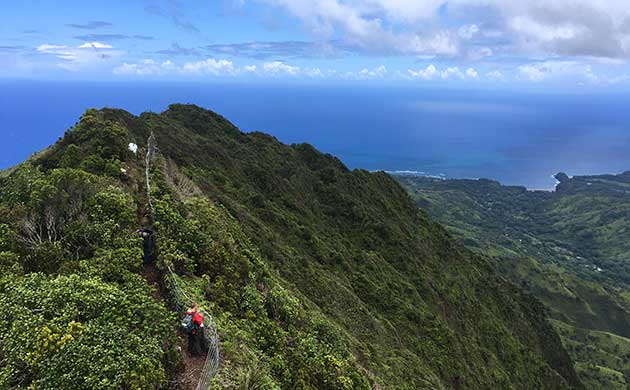
What is Pacific Science?
It’s a peer-reviewed scientific journal, which generally pushes forward the envelope of our understanding of the scientific world in many fields. Pacific Science, specifically, is an interdisciplinary publication put out by the University of Hawaiʻi Press to highlight the work of University of Hawaiʻi researchers. So it’s very much a regional journal, but it touches on topics that are of interest to researchers around the planet.
Previously you said you want to get the word out beyond the scientific community — more into the public sphere, yes?
Yes, very much so. Part of what we endeavor to do is influence policy. One of the metrics policymakers use is scientific research. We use scientific research to inform our adaptive management of the valley and to demonstrate our successes so we can be a model for policymakers.
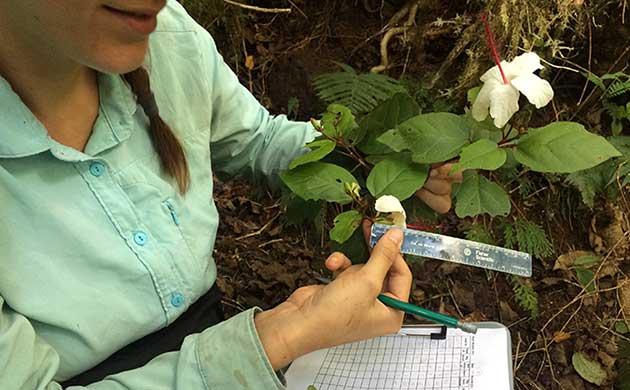
Are these articles available for anyone online?
Yes, this whole special issue is open source. Quite often you have to pay to read journal articles, but we made it such that anyone can look at it [view here].
While these articles are aimed at a scientific audience, our role as a botanical garden is ultimately to interpret science for the general public. Our scientific understanding of the world is always evolving, which is why it’s incumbent upon us to be adaptive in our interpretation of science. We can have a real impact when we interpret these concepts to our visitors.
And the second article featuring research from the Upper Limahuli Preserve was about the importance of preserving habitat for endangered seabirds?
Yes, it was about nutrient cycling and seabirds. The lead author was helicoptering into the preserve with members of the Kaua’i Endangered Seabird Recovery Project. She accompanied them as they monitored seabird burrows, helping and collecting data at the same time.
Limahuli is one of the last places in Hawai’i to have a relatively healthy population of our two critically endangered seabirds — the ʻa’o, or Newell’s shearwater, and the Hawaiian petrel, ‘ua’u, — and we often speak about the role these birds play in the health of the forest system. It’s multi-faceted; they’re important culturally and they’re important ecologically. We’re trying to garner support for our efforts to make sure these birds don’t go extinct.
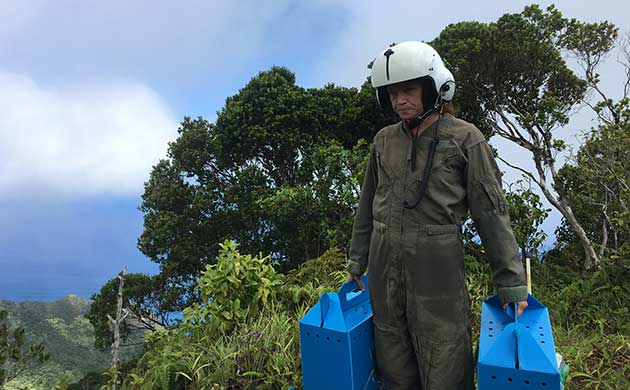
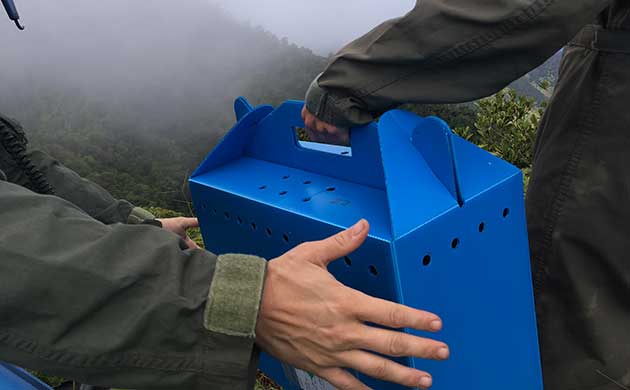
Until now we haven’t had much scientific documentation about the importance of seabirds in nutrient cycling in our forest, particularly with nitrogen and phosphorous. In the past, when there were millions of these birds nesting in the mountains, their waste produced nutrients that were cycled in from the ocean – thus providing a steady input of fertilizer that a whole forest community evolved to depend on.
But when seabird populations collapse and forest plants lose the nutrient sources they co-evolved with, they are not as resilient to catastrophic changes such as the threat of invasive species.
“When we talk about restoring forests, it’s much more than just making sure the plants are still around. We have to preserve the habitat that is conducive to their health and vitality, and that habitat includes colonies of seabirds.” —Dr. Kawika Winter
For those who aren’t familiar with Limahuli, would you say there is something different or unique that you won’t find anywhere else in Hawai’i?
Well, I certainly think so. It’s the second-most biodiverse valley in all of Hawai’i with an ecosystem that is unique even by Hawai’i standards in terms of the number of species that co-exist here in the valley. The Upper Limahuli Preserve is one of the last jewels — the last refugia — of biodiversity on Kaua’i due in large part to our stewardship of the valley.
The cover image of this issue of Pacific Science was created by NTBG staff, yes?
Right. We’re very lucky to have GIS Technician Ben Nyberg, who is really skilled at visually interpreting the research we do.
Can you describe the cover?
Imagine looking at the landscape of Limahuli Valley as if you were flying in a helicopter so you can see the valleys, peaks, ridges, and the flatlands. Overlaid on that are the different social-ecological zones in various colors.
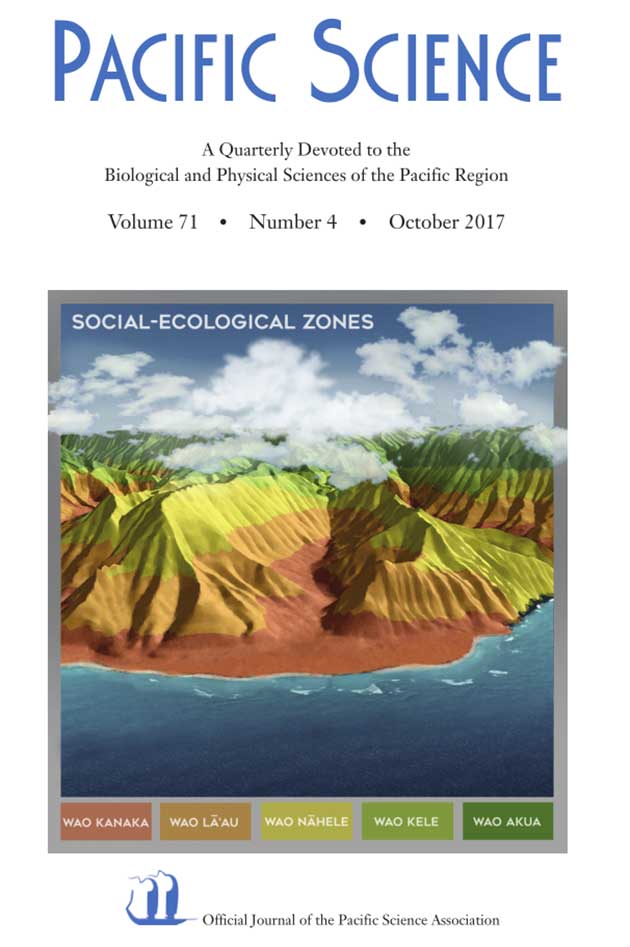
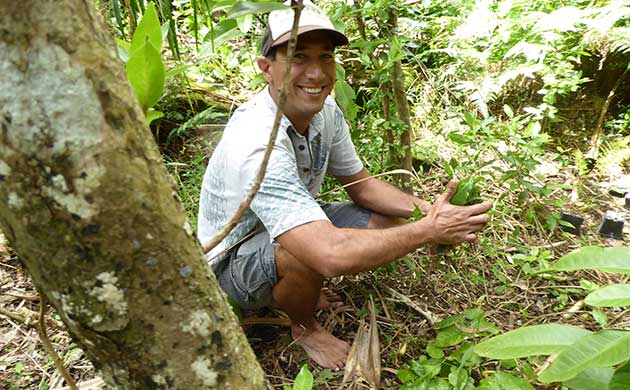
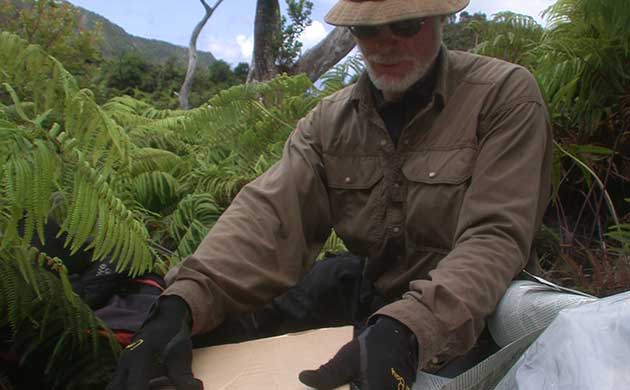
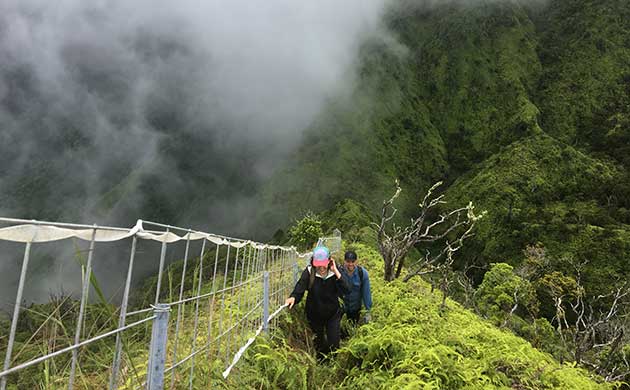
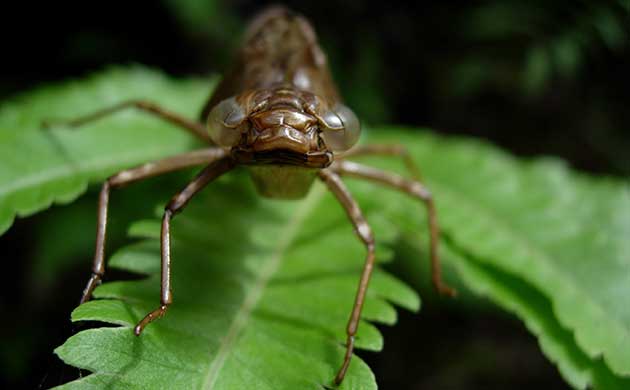
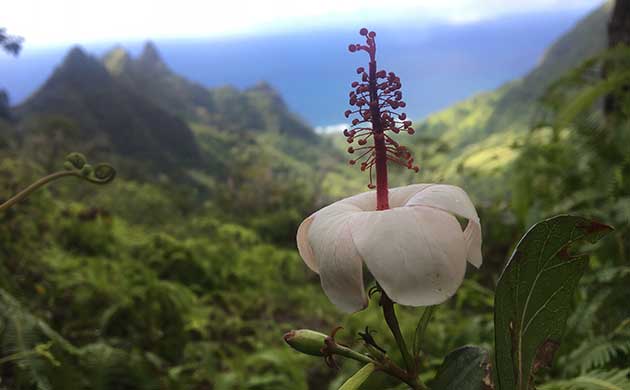
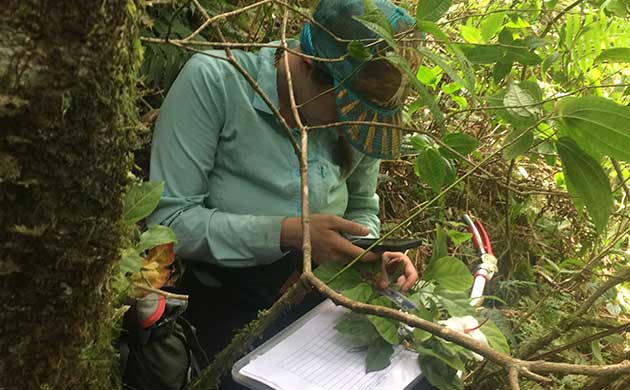
You have the wao kanaka — the social-ecological zone that was appropriate for habitation, cultivation, agriculture, aquaculture, and recreation. And then you have varying zones that extend into the forest that include an integrated agroforestry zone with Polynesian and native plants managed together to maximize biodiversity. There are also various zones of remote forest, including one used primarily by feather gatherers in the ancient days. Then two areas of forest that are in the core watershed include the summit, which was once designated as wao akua — the sacred forest.
“One of the goals of our paper is to demonstrate how the conservation work we are doing is actually aligned with traditional resource management.” — Dr. Kawika Winter
The third recently published article was entitled Biocultural approaches to well-being and sustainability indicators across scales in the journal Nature Ecology & Evolution. It was co-authored by you and some 40 scientists, policymakers, and on-the-ground practitioners. Tell us about the article and what you contributed.
The premise of the article recognizes that the work we do is happening both on the local level and it’s happening on the policy level. There’s been a huge disconnect when policies are made at the governmental or international level, but they aren’t aligned with what’s happening on the ground. We’re not seeing the successes that we need to see because of this disconnet.
The international metrics are not measured in ways that are meaningful to people on the ground, and, conversely, the ways that are meaningful to people on the ground are not being paid attention to by those external sources that are influencing policy.
A huge contribution of this paper was in demonstrating ways to build bridges between those two realms, because whatever policies are made at the highest echelons of international and government policymaking, if the people on the ground don’t buy into it it’s never going to happen. This paper showed examples of building such bridges between local systems and external systems.
Part of what we’re doing at Limahuli Garden and Preserve — the efforts of NTBG — is a really great example of this. We’re trying to highlight ways to protect areas that are aligned with cultural values and community priorities.
Many people know Limahuli as a beautiful botanical garden with strong cultural and historical ties, they know it as a place for the conservation of rare and native plants, and they know it as a place that has very close ties to the local community. Fewer people know how much scientific research happens at Limahuli. So why is the Limahuli Preserve so important to researchers in different fields?
Limahuli is actually one of the most researched ahupua’a in all of Hawai’i. That’s not by mistake, that’s by design; and in many ways it has been really useful in helping us to adaptively manage our biocultural resources and set policies that are going to ensure an abundance of these resources in the future.
One of the reasons why it is such an amazing area of interest is because this is the second-most biodiverse valley in Hawai’i. The interconnectedness and diversity make Limahuli one of the places that can provide answers to many of the problems we face on this planet.
As one example, I take every opportunity to get entomologists into Limahuli. Every time insect researchers have come in here they’ve found something new or they have rediscovered something that was thought to be extinct. There are so many unknown questions about what is actually pollinating these plants and our mission is to save plants, right? “To perpetuate the survival of plants, ecosystems, and cultural knowledge…” is in our mission statement and research helps us to accomplish that.
Plants aren’t going to survive without their co-evolutionary partners — especially plants in Hawai’i — so we have a vested interest in ensuring that all of our plants’ coevolutionary partners survive as well.
“If we lose those elements of a forest, then our plants are only going to survive as museum specimens.” — Dr. Kawika Winter
Limahuli Preserve is all about conserving and restoring the health and function of that system, and all the elements in it. But we don’t understand the interconnectedness of everything yet, so it’s a really ripe area for research on almost every front you can imagine — ecology, biology, entomology, hydrology — and then you overlay the fishery and all related cultural elements and you can really get a picture of systems-based research.
So in order for us to make the best decisions, we need to have a good scientific understanding. Part of my role involves being a lead collaborator in the Hā’ena Ahupua’a Alliance, which is a partnership between us and a community group, Hui Maka’āinana O Makana. Collectively, we’ve formed an alliance to collaboratively manage all of the biocultural resources from the top of the ahupua’a all the way out into the ocean. One of the roles of Limahuli Garden and Preserve in the context of that alliance is to coordinate the research that is going to inform our adaptive management of the biocultural resources in this ahupua’a such that it can serve as a model for Hawai’i.
All too often researchers come from the outside with their own obscure and tangential interests that aren’t aligned with anything the community is interested in. It’s important to acknowledge the existence of the community and address their concerns in the process of conducting research.
It is in this way that we’re trying to also set up a different model of how research happens in Hawai’i. We’ve had a lot of success doing that from the bottom to the top, and hopefully we’ll continue to enjoy more as time moves on.
Photography and video by Zak DeWalt, Chiemi Nagle, Ben Nyberg, Seana Walsh, Ken Wood, and other NTBG staff